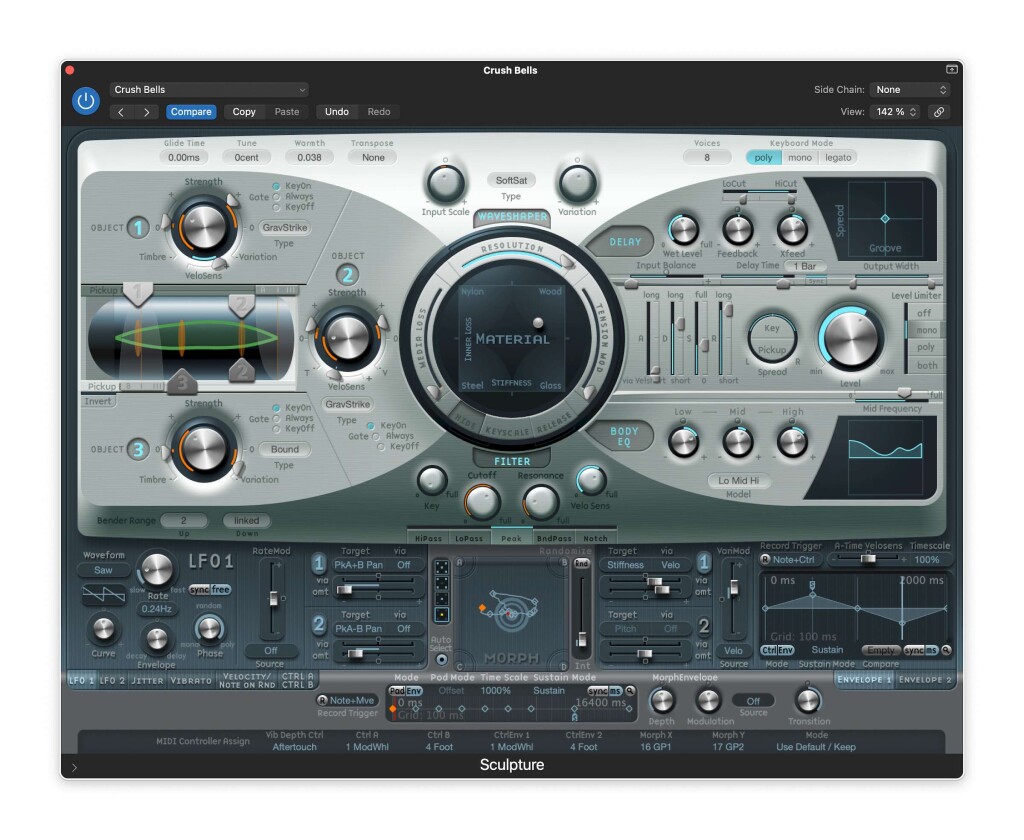Over 20 years later, Apple’s Sculpture instrument still vibrates, resonates, and morphs like no other physical modeling synth. It’s crazy, unruly, sometimes delightfully unpredictable – you just need to find your way in. So let’s return to some “vintage” tutorials to do just that, especially as there’s a good chance you’ve got Sculpture just waiting for you inside a copy of Logic Pro.
Sculpture debuted all the way back at Logic Pro 7 in September 2004, not long after Apple’s 2002 acquisition of Emagic. This was Apple’s first true major release of the DAW, as Logic Pro 6 was mainly a re-bundling of Emagic’s Logic 6. I had to look this up just to remember; I reviewed Logic in early 2005 in Macworld, in an era when those reviews ran in print.

Sculpture is one of the few Emagic/early Apple UIs that hasn’t gotten a refresh, alongside Ultrabeat (also a Logic Pro 7 addition) and all the synths beginning with “E” (a clue that they’re from the Emagic era). Heck, even Klopfgeist, the metronome, got a new UI. But I have to hope that Apple gives Sculpture a suitably Sculpture-ish look, not just more generic knobs. Meanwhile, the interface is squint-worthy but also has ingenious touches, like the single-screen approach and visualizations of the string model. (Before someone at Apple yells at me, there have been under-the-hood enhancements – a lot of optimization and 5.1 surround support – but the UI is the same apart from the window itself; you can verify this in Sound on Sound’s Logic 7 screenshot, among others.)
And Sculpture is newly relevant thanks to the introduction of Logic Pro for iPad. Sculpture is fully editable in its iPad edition, even if reduced to pages of knobs. And it offers a second way to play Sculpture as an instrument, without necessarily using your laptop.
But I love Sculpture for its sound possibilities. There are tons of great physical modeling options, but nothing offers Sculpture’s architecture: three exciter/disturber objects, a deep resonator structure with loads of parameters, configurable body EQ, and waveshaper, all with advanced morphing, modulation, and MIDI controller assignment. That includes full MPE support – imagine Osmose with Sculpture on an iPad on a music stand.
Part of the strength of other instruments is that they are generally voiced and configured for good-sounding results across the parameter range, as on instruments by Stephan Schmitt, AAS, and others. And they choose a limited number of models and make these manageable in the interface. Sculpture is the opposite. It’s the Holodeck with no safety protocols. Add as much as you want. Distort the sound. Accidentally create feedback. Short of digging into code in an environment like SuperCollider, you’re probably not going to find this many options in a physical model. It’s simply insane – and since it is 20+ years old (read about me struggling to run it on a 2004 PowerBook), now you can comfortably add as many Sculpture instances as you want, even on the iPad.
If there’s no instrument like Sculpture, there’s no Logic clinician like Steve Horelick. So I found myself today re-linking his videos for my class – and watching them again myself. The full Logic 205 course includes more (and is presumably at a higher res than 480p), but this is still a great starting place – even for me, having used Sculpture for years.
Logic 205: Synthesis With Sculpture – 04. Intimate Relationships (weird title, but actually explains a lot about how to approach this)
Logic 205: Synthesis With Sculpture – 05. Exciters and Disturbers
Logic 205: Synthesis With Sculpture – 22. Morph Section Geography
Breeding sounds:
While there isn’t a separate effect version of Sculpture (like AAS’ Corpus in Ableton Live, the resonator section from Collision), you can sidechain into Sculpture, too, as in this (non-Steve) tutorial:
It’s good stuff. I never get tired of this one. So it’s well worth the reminder that it’s in there.
And yeah, this is the same Steve Horelick who wrote the Reading Rainbow theme – and showed up to demonstrate the Fairlight CMI. In those days, just owning a synth like the Fairlight was often enough to land you a gig. But then it’s great to see that synthesis is now accessible – indeed, to the entire Reading Rainbow audience, grown up now, instead of just one person. And it’s equally great to see that in that age of democratization, Steve’s knowledge of synths demonstrates that musicianship still matters.
Check Steve’s official site. (Suffice to say Reading Rainbow is just the beginning, but – what a beginning, as I’m sure that one segment alone directed at least some CDM readers to get into electronic music! Well that and Suzanne Ciani on 3-2-1 Contact, of course. Hey we should all get together and make some multilingual program for kids, huh? Can you tell me how to get to CDM Street?)